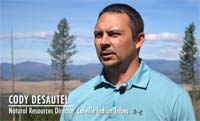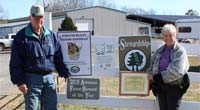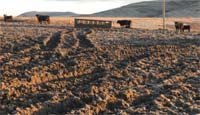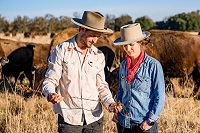Browse our Growing Library of Success Stories
By:
Gregg Elliott When Heather Dutton, fresh out of undergraduate school at the Warner College of Natural Resources and graduate school in the College of Agriculture at Colorado State University, began her first job working for a non-profit river restoration organization in the San Luis Valley, she was thrilled. She also felt confident that her technical training in restoration ecology had prepared her for the challenges she’d soon be facing.
When Heather Dutton, fresh out of undergraduate school at the Warner College of Natural Resources and graduate school in the College of Agriculture at Colorado State University, began her first job working for a non-profit river restoration organization in the San Luis Valley, she was thrilled. She also felt confident that her technical training in restoration ecology had prepared her for the challenges she’d soon be facing.
Heather was in for a surprise.
https://www.landcan.org/success/When-Conservation-Happens-Collaboratively/3523/
By:
Steve Stuebner Ten years in the making, the objective of the project was to keep “working forests working,” while knitting together checkboard-ownership of private lands with state endowment trust lands to provide open space for moose, elk, deer and bears to travel a between the Cabinet Mountains to the east and the Selkirk Mountains to the west via a narrow valley, known as the “Purcell Trench,” surrounding the McArthur Lake WMA.
Ten years in the making, the objective of the project was to keep “working forests working,” while knitting together checkboard-ownership of private lands with state endowment trust lands to provide open space for moose, elk, deer and bears to travel a between the Cabinet Mountains to the east and the Selkirk Mountains to the west via a narrow valley, known as the “Purcell Trench,” surrounding the McArthur Lake WMA.
https://www.landcan.org/success/McArthur-Lake-Forest-Legacy-Easement/3617/
By:
Leopold Conservation Award Program J. David Bamberger’s Selah, Bamberger Ranch Preserve stands as a motivating symbol of the power of private landowner conservation.
J. David Bamberger’s Selah, Bamberger Ranch Preserve stands as a motivating symbol of the power of private landowner conservation.
https://www.landcan.org/success/Selah-Bamberger-Ranch-Preserve/3410/
By:
Leopold Conservation Award Program Land stewardship is about balance. If a ranch is managed solely for the purpose of grazing cattle, the rest of its ecosystem falls out of balance. Hugh Fitzsimons Jr. embraced a more holistic approach at his San Pedro Ranch in the 1970s. He believed if you improved native habitat, the ecosystem would not only lead to more wildlife, but to healthier livestock.
Land stewardship is about balance. If a ranch is managed solely for the purpose of grazing cattle, the rest of its ecosystem falls out of balance. Hugh Fitzsimons Jr. embraced a more holistic approach at his San Pedro Ranch in the 1970s. He believed if you improved native habitat, the ecosystem would not only lead to more wildlife, but to healthier livestock.
https://www.landcan.org/success/San-Pedro-Ranch/3714/
By:
Mark Davis, USFWS Public Affairs Specialist Georgia landowner Charley Tarver committed to helping the endangered red-cockaded woodpecker. Joe Burnam, a biologist with the Georgia Department of Natural Resources (DNR) credits Tarver, and the DNR’s Safe Harbor Agreement, with creating a healthy environment for the birds.
Georgia landowner Charley Tarver committed to helping the endangered red-cockaded woodpecker. Joe Burnam, a biologist with the Georgia Department of Natural Resources (DNR) credits Tarver, and the DNR’s Safe Harbor Agreement, with creating a healthy environment for the birds.
https://www.landcan.org/success/Safe-harbor-for-woodpeckers/3702/
By:
Phil Kloer, USFWS Public Affairs Specialist Across the country, golf courses are converting acreage to monarch butterfly habitat. The USGA helps fund Monarchs in the Rough, an Audubon International project to establish monarch habitats on American golf courses.
Across the country, golf courses are converting acreage to monarch butterfly habitat. The USGA helps fund Monarchs in the Rough, an Audubon International project to establish monarch habitats on American golf courses.
https://www.landcan.org/success/Teeing-up-conservation/3701/
By:
Natural Resources Conservation Service This video is the story of a young scientist, Hugh Hammond Bennett, who recognized 80 years ago that the United States was at risk of losing it’s most important resource – its soil. He made it his mission to change the trajectory of agriculture at a time of great crisis and to provide farmers and ranchers with the information and tools they needed to be sustainable.
This video is the story of a young scientist, Hugh Hammond Bennett, who recognized 80 years ago that the United States was at risk of losing it’s most important resource – its soil. He made it his mission to change the trajectory of agriculture at a time of great crisis and to provide farmers and ranchers with the information and tools they needed to be sustainable.
This 21 minute video is the story of the conservation movement that Hugh Hammond Bennett began and includes interesting insights into the policies and structures that he set up that we continue to rely on today. His work revealed so much of what we’re rediscovering and renaming as “regenerative agriculture.”
https://www.landcan.org/success/Hugh-Hammond-Bennett-The-Story-of-Americas-Private-Lands-Conservation-Movement/3642/
 This is a neat story about dreams coming true. Preston, Idaho rancher Jay Wilde had a dream of restoring beaver to Birch Creek on his cattle ranch near Preston in Southeast Idaho. He tried to restore beaver on his own nickle, but they didn't stay. Jay eventually reached out to Joe Wheaton, a watershed scientist at Utah State University, who helped him solve the puzzle. See how Jay worked with Wheaton and Nick Bouwes from Utah State and Anabranch Solutions to introduce beaver successfully with a science-based plan and low-tech woody structures to create deep-water habitat for beavers.
This is a neat story about dreams coming true. Preston, Idaho rancher Jay Wilde had a dream of restoring beaver to Birch Creek on his cattle ranch near Preston in Southeast Idaho. He tried to restore beaver on his own nickle, but they didn't stay. Jay eventually reached out to Joe Wheaton, a watershed scientist at Utah State University, who helped him solve the puzzle. See how Jay worked with Wheaton and Nick Bouwes from Utah State and Anabranch Solutions to introduce beaver successfully with a science-based plan and low-tech woody structures to create deep-water habitat for beavers.
https://www.landcan.org/success/Rancher-Jay-Wilde-realizes-longtime-dream-of-bringing-beaver-back-to-Birch-Creek/3641/
By:
Ted Williams Unlike most New England rivers, the East Machias River never quite lost its salmon. Every fall, a small remnant population swam upstream, against waters that tumble and curl 36 miles from Crawford Lake to the coast, through balsam-scented boreal forest where moose splash and eastern coyotes sing. The Downeast Salmon Federation’s weathered, cedar-shingled Peter Gray Hatchery sits along the bank, just below a narrow stretch of rapids that empties into the river’s wide, flat tidal reaches.
Unlike most New England rivers, the East Machias River never quite lost its salmon. Every fall, a small remnant population swam upstream, against waters that tumble and curl 36 miles from Crawford Lake to the coast, through balsam-scented boreal forest where moose splash and eastern coyotes sing. The Downeast Salmon Federation’s weathered, cedar-shingled Peter Gray Hatchery sits along the bank, just below a narrow stretch of rapids that empties into the river’s wide, flat tidal reaches.
https://www.landcan.org/success/The-Experimental-Method-That-Might-Just-Save-Maines-Salmon/3620/
By:
Steve Stuebner Pine Street Woods opened to great fanfare last autumn. Now the Sandpoint community has a new outdoor space for walking, biking, cross country skiing, connecting with nature and learning about sustainable land management.
Pine Street Woods opened to great fanfare last autumn. Now the Sandpoint community has a new outdoor space for walking, biking, cross country skiing, connecting with nature and learning about sustainable land management.
“We were passionate about this – the idea of having a piece of nature close in, for our entire community to come out and explore, and play, recreate and learn,” said Katie Egland Cox, Executive Director of the Kaniksu Land Trust.
https://www.landcan.org/success/Kaniksu-Land-Trust-creates-Pine-Street-Woods/3619/
By:
Steve Stuebner See how Lemhi ranchers and conservation professionals work together to achieve a number of milestones related to fish and wildlife habitat, water conservation, minimum stream flows, winter fish survival and more through careful advance planning, respect for multiple uses, and a clear focus on conservation and community goals.
See how Lemhi ranchers and conservation professionals work together to achieve a number of milestones related to fish and wildlife habitat, water conservation, minimum stream flows, winter fish survival and more through careful advance planning, respect for multiple uses, and a clear focus on conservation and community goals.
https://www.landcan.org/success/Lemhi-Ranchers-enhance-fish-habitat-via-25year-harmonious-partnership/3616/
By:
Washington Policy Center This video from Washington Policy Center with cooperation from the Confederated Tribes of the Colville Reservation, sheds light on how the tribes manage forests to be more healthy using commercial harvests, thinnings, and controlled burns to deal with the pressures of insect infestation, climate change, and decades of fire suppression.
This video from Washington Policy Center with cooperation from the Confederated Tribes of the Colville Reservation, sheds light on how the tribes manage forests to be more healthy using commercial harvests, thinnings, and controlled burns to deal with the pressures of insect infestation, climate change, and decades of fire suppression.
https://www.landcan.org/success/Healthy-and-FireResilient-Forests-with-the-Confederated-Tribes-of-the-Colville-Reservation/3614/
By:
Steve Stuebner Before knowing much about land trusts, Ashton farmer John Nedrow thought they were some kind of sinister force seeking to take over his farm and force landowners off their property.
Before knowing much about land trusts, Ashton farmer John Nedrow thought they were some kind of sinister force seeking to take over his farm and force landowners off their property.
“Back then, I thought they were the enemy,” Nedrow said in an interview on his alfalfa and malt-barley farm, which straddles the banks of the famed Henrys Fork River, a blue-ribbon trout stream. “I thought they wanted to turn this whole area into national park.”
https://www.landcan.org/success/John-Nedrow-is-a-big-believer-in-conservation-easements--they-saved-his-family-farm/3613/
 Their introduction to holistic ranch management techniques called into question long-held, traditional ways of thinking. The drastic changes that followed required a leap of faith for the fourth-generation ranchers. They traded harvesting hay for grazing methods that let their cattle harvest the forage themselves. Such changes didn’t happen overnight, and each came with its own risk and learning curve.
Their introduction to holistic ranch management techniques called into question long-held, traditional ways of thinking. The drastic changes that followed required a leap of faith for the fourth-generation ranchers. They traded harvesting hay for grazing methods that let their cattle harvest the forage themselves. Such changes didn’t happen overnight, and each came with its own risk and learning curve.
https://www.landcan.org/success/Craig-and-Conni-French-always-considered-themselves-good-land-stewards/3609/
By:
Steve Stuebner Extensive outreach by Pioneers Alliance conservation partners and ground-breaking research on antelope migration patterns, funded by the Lava Lake Institute for Science and Conservation and Wildlife Conservation Society, has led to the protection of approximately 94,000 acres of private ranchland rich with wildlife values particularly for sage grouse and antelope.
Extensive outreach by Pioneers Alliance conservation partners and ground-breaking research on antelope migration patterns, funded by the Lava Lake Institute for Science and Conservation and Wildlife Conservation Society, has led to the protection of approximately 94,000 acres of private ranchland rich with wildlife values particularly for sage grouse and antelope.
https://www.landcan.org/success/Landownerled-campaign-protects-94000-acres-of-habitat-on-private-lands/3601/
By:
Jonathan Baxter, Partners for Fish and Wildlife Biologist Many partners yield many benefits for Arkansas ranch and the butterflies that live there. Diamond TR Ranch is an example of what can be accomplished when partnerships, programs and professionals work together to accomplish the landowners goals.
Many partners yield many benefits for Arkansas ranch and the butterflies that live there. Diamond TR Ranch is an example of what can be accomplished when partnerships, programs and professionals work together to accomplish the landowners goals.
https://www.landcan.org/success/Monarchs-on-the-ranch/3594/
By:
Steve Stuebner
Over 16 Idaho County ranchers signed up to install BMPs
In the beautiful rolling draws and hills of North Idaho’s Camas Prairie, numerous Idaho County cattle ranchers are stepping up to install a host of best management practices on cattle wintering grounds to get their livestock out of the mud and improve water quality in Red Rock Creek, Cottonwood Creek and the South Fork of the Clearwater River.
https://www.landcan.org/success/Partners-Reduce-Mud-Improve-Water-Quality-on-Camas-Prairie-Waterways/3593/
By:
Steve Stuebner
Like many ranchers, Mayfield rancher Jeff Lord watches for opportunities to improve the public range where his cattle graze.
Following the 280,000-acre Pony-Elk Complex wildfires in 2013, Lords partnered with state and federal agencies to assist with range-rehabilitation projects in the Danskin Mountains.
https://www.landcan.org/success/Restoring-rangelands-in-the-Danskin-Mountains-of-Idaho/3591/
By:
University of MaineTour U.S. Forest Service research at the Penobscot Experimental Forest and see how different kinds of silviculture and harvesting have changed the forest over more than half a century. Learn from experts at the University of Maine, Maine Forest Service, Maine Audubon, and others around the state about how to manage your woodlot for the future, considering timber production, climate change, pests and disease.
https://www.landcan.org/success/Forestry-for-the-Future-Lessons-in-Sustainable-Management-from-Maine/3588/
By:
Texas Parks and Wildlife Foundation Taylor Collins’ and Katie Forrest’s life journey has taken them from restoring their bodies to restoring their land. The once-vegetarian Austin couple went vegan after health issues got in the way of sports training. When things got worse, they consulted a nutritionist who urged them to add clean meat protein to their diet.
Taylor Collins’ and Katie Forrest’s life journey has taken them from restoring their bodies to restoring their land. The once-vegetarian Austin couple went vegan after health issues got in the way of sports training. When things got worse, they consulted a nutritionist who urged them to add clean meat protein to their diet.
https://www.landcan.org/success/We-Will-Not-Be-Tamed-Meet-Taylor-and-Katie/3565/
 Sign In
Sign In
 Sign In
Sign In
